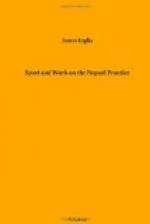I have been out with a line of seventy-six elephants and fourteen howdahs. This was on 16th March 1875. It was a magnificent sight to see the seventy-six huge brutes in the river together, splashing the water along their heated sides to cool themselves, and sending huge waves dashing against the crumbling banks of the rapid stream. It was no less magnificent to see their slow stately march through the swaying, crashing jungle. What an idea of irresistible power and ponderous strength the huge creatures gave us, as they heaved through the tangled brake, crushing everything in their resistless progress. It was a sight to be remembered, but as might have been expected, we found the jungles almost untenanted. Everything cleared out before us, long ere the line could reach its vicinity. We only killed one tiger, but next day we separated, the main body crossing the stream, while my friends and myself, with only fourteen elephants, rebeat the same jungle and bagged two.
In every hunt, one member is told off to look after the forage and grain for the elephants. One attends to the cooking and requirements of the table, one acts as paymaster and keeper of accounts, while the most experienced is unanimously elected captain, and takes general direction of every movement of the line. He decides on the plan of operations for the day, gives each his place in the line, and for the time, becomes an irresponsible autocrat, whose word is law, and against whose decision there is no appeal.
Scouts are sent out during the night, and bring in reports from all parts of the jungle in the early morning, while we are discussing chota baziree, our early morning meal. If tiger is reported, or a kill has been discovered, we form line in silence, and without noise bear down direct on the spot. In the captain’s howdah are three flags. A blue flag flying means that only tiger or rhinoceros are to be shot at. A red flag signifies that we are to have general firing, in fact that we may blaze away at any game that may be afoot, and the white flag shews us that we are on our homeward way, and then also may shoot at anything we can get, break the line, or do whatever we choose. On the flanks are generally posted the best shots of the party. The captain, as a rule, keeps to the centre of the line. Frequently one man and elephant is sent on ahead to some opening or dry water-bed, to see that no cunning tiger sneaks away unseen. This vedette is called naka. All experienced sportsmen employ a naka, and not unfrequently where the ground is difficult, two are sent ahead. The naka is a most important post, and the holder will often get a lucky shot at some wary veteran trying to sneak off, and may perhaps bag the only tiger of the day. The mere knowledge that there is an elephant on ahead, will often keep tigers from trying to get away. They prefer to face the known danger of the line behind, to the unknown danger in front, and in all cases where there is a big party a naka should be sent on ahead.




